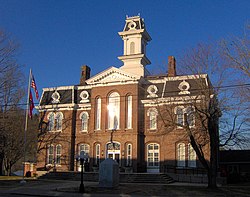Carthage, Tennessee
| Carthage, Tennessee | |
|---|---|
| Town | |

Smith County Courthouse in Carthage
|
|
 Location of Carthage, Tennessee |
|
| Coordinates: 36°15′18″N 85°56′57″W / 36.25500°N 85.94917°W | |
| Country | United States |
| State | Tennessee |
| County | Smith |
| Settled | 1789 |
| Incorporated | 1804 |
| Named for | Ancient Carthage |
| Area | |
| • Total | 2.9 sq mi (7.4 km2) |
| • Land | 2.9 sq mi (7.4 km2) |
| • Water | 0.0 sq mi (0.0 km2) |
| Elevation | 515 ft (157 m) |
| Population (2010) | |
| • Total | 2,306 |
| • Density | 807/sq mi (311.4/km2) |
| Time zone | Central (CST) (UTC-6) |
| • Summer (DST) | CDT (UTC-5) |
| ZIP code | 37030 |
| Area code(s) | 615 |
| FIPS code | 47-11280 |
| GNIS feature ID | 1279827 |
Carthage is a town in and the county seat of Smith County, Tennessee, United States; it is part of the Nashville Metropolitan Statistical Area. The population was 2,306 at the 2010 census. It is located on the Cumberland River, which was important to its early development. It is likely best known as the hometown of former Vice President and Senator Al Gore of the Democratic Party and his father, Senator Albert Gore, Sr. The younger Gore announced his 1988 and 2000 presidential bids, as well as his 1992 vice-presidential bid, from the steps of the Smith County Courthouse.
The earliest known European-American settler in what is now Carthage was William Walton (1760–1816), who arrived in the late 1780s after the United States achieved independence in the American Revolutionary War.Circa 1800, Walton directed the construction of the Walton Road (Cumberland Turnpike), an early stagecoach route connecting the Knoxville area in the east with Middle Tennessee. The road, which was roughly paralleled later by the construction of what is now U.S. 70, was influential to the development and early settlement of the Cumberland region. Walton operated a ferry across the Cumberland River and a tavern nearby along the road, around which a small community developed. In 1804, Walton's community was chosen as the county seat of the newly formed Smith County after a heated election, and the town of Carthage was laid out shortly thereafter.
Carthage's location at the confluence of the Caney Fork and Cumberland rivers made it an important shipping and steamboat port throughout the first half of the 19th century. The area was developed for tobacco and hemp crops, as well as blooded livestock. Goods were shipped downstream to Nashville. During the Civil War, Carthage became an important post in the Eastern Highland Rim area of Tennessee. Carthage was selected as part of the route Confederate General Braxton Bragg marched the Army of Mississippi through on his Confederate Heartland Offensive into Kentucky. Later on March 6, 1863, Union Brigadier General George Crook established a Union outpost in Carthage to serve as a base for his effort to clear out the considerable Confederate guerrilla insurgency from east Tennessee through middle Tennessee.
...
Wikipedia
